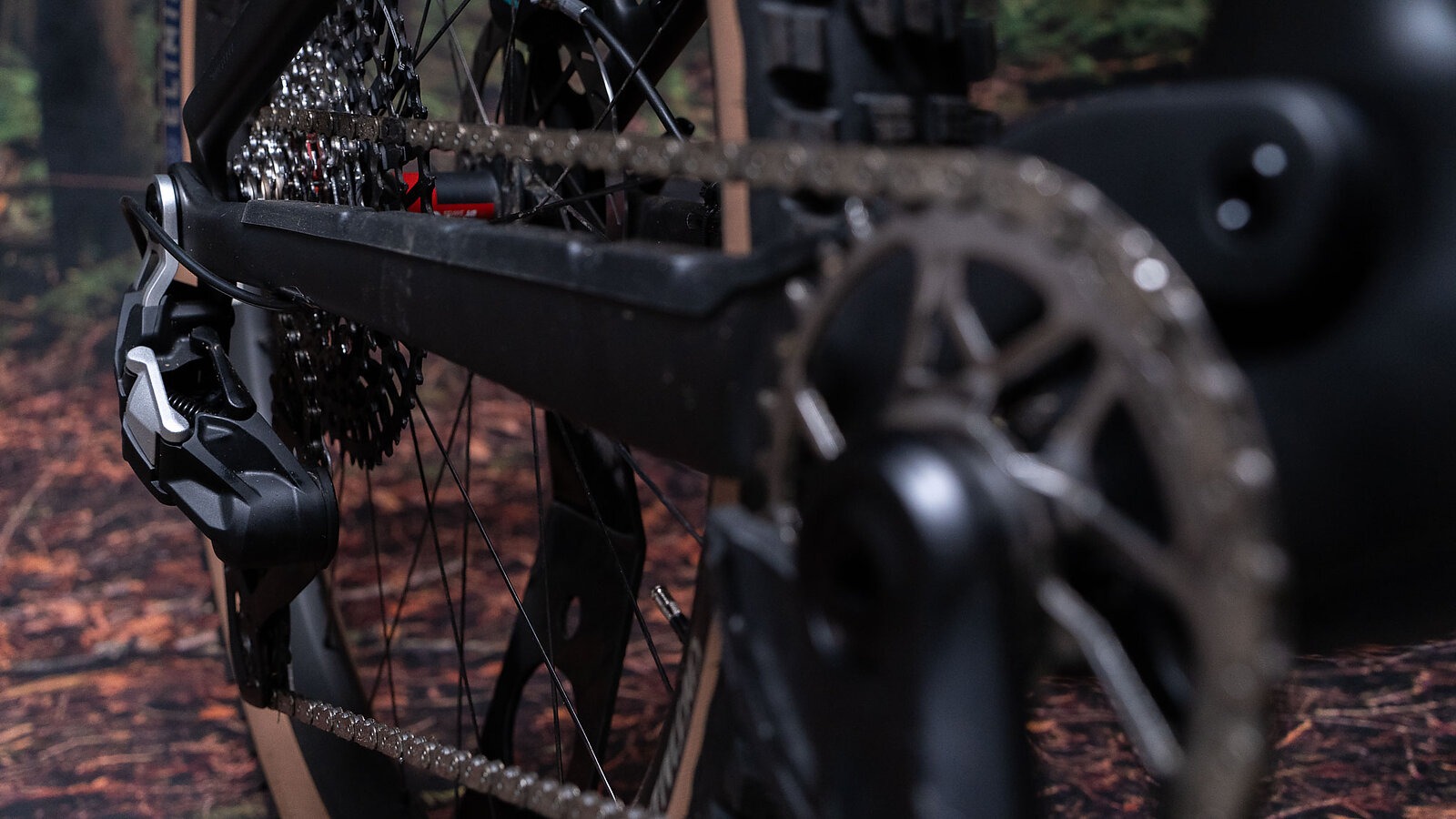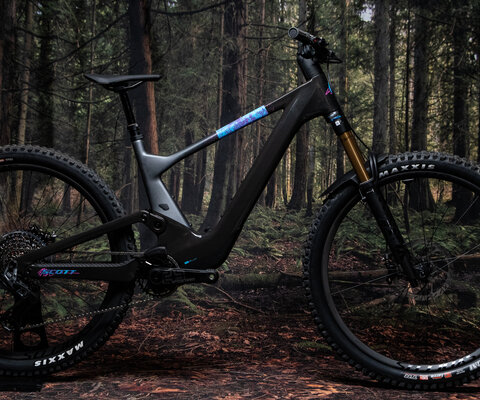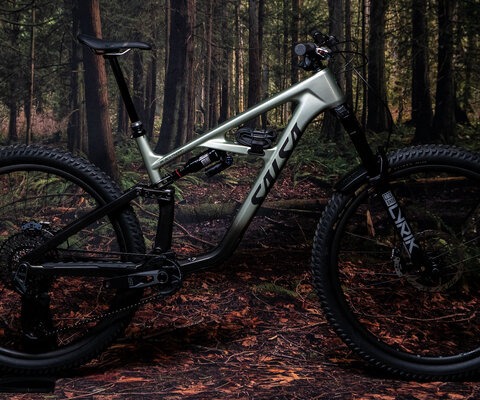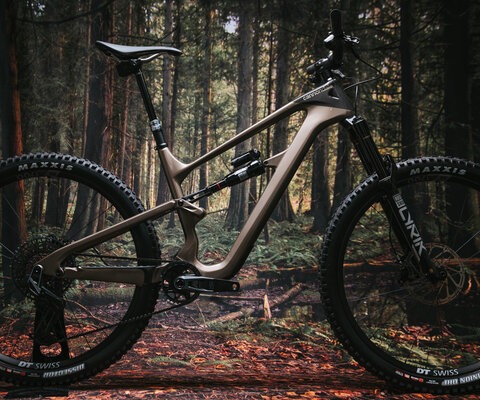
SRAM Eagle 90 Mechanical Transmission Component Review
Words and Photos by Cy Whitling
Look mom, no batteries!
Mechanical Transmission has landed. No batteries, cables are in again, time to buy some stick-on guides for the bike you bought last year that doesn’t have routing for a derailleur cable! The short version? SRAM’s Eagle 90 mechanical Transmission delivers the direct-mount performance you’d expect, with a satisfying shift feel, and an impressive level of rebuildability. But there’s a lot more going on here, so let’s dive in.
And, if you missed it, SRAM also launched a new Motive brake today that we’ve also reviewed.

SRAM Eagle Mechanical Transmission Overview
- Speeds: 12 (10-52 tooth)
- Multi-shift or single shift e-bike varients
- Models Available: 70, 90
- Stated System Weight: 2,085 g
- MSRP: $695
Transmission, Now With Cables
According to SRAM, this mechanical Transmission system has been in the works for six years, but it turned out to be easier to perfect and launch the electronic version first. But now, two years after everyone in the bike industry posted photos of themselves standing on their hangerless derailleurs, we’ve got a cable-driven version.
Just like the electronic version, this new Transmission replaces the “H” (hanger) on UDH frames with its direct mount, and doesn’t have B-tension or limit-adjust screws. It follows the same “loosen, tension, tighten” setup procedure, and has the same ability to shift under load, as well as being SRAM’s most rebuildable derailleur ever. And, as an added bonus, the DUB cap on the cranks takes an 8-millimeter hex now, which should lead to fewer of them lost on the trail.
It’s available in two trim levels, with several other options, and is, of course, compatible with the rest of the Transmission ecosystem.

Mechanical Transmission 90 vs 70
There are two cable-driven Transmission options, the 90 (reviewed here) and the more affordable 70. SRAM’s mantra is “Start with 70, upgrade with 90” and there are several key differences between the two groups. 70 uses the same HG mount two-piece cassette as the electronic S1000 group, while 90 uses the one-piece XD cassette that comes with GX Transmission, and 90’s derailleur is more rebuildable, and uses the same clutch as the other Transmission models, rather than the 70’s drag spring damper. Similarly, the 90 uses SRAM’s newer 8-bolt crank/chainring interface, while the 70 uses the older 3-bolt design, the 90 gets alloy shifter levers and the 70 gets plastic.
As you’d expect, each component of the 90 drivetrain is a little lighter, and a little more expensive than its 70 counterpart. Here’s a quick breakdown:

About $200 and 200 grams separate the two drivetrains. The 90 group will be available aftermarket complete for $670, while you’ll have to piece together a 70 group if you want one.
For context, an electronic GX Transmission group will run you $1,099 and weighs 2,007 grams, while an old GX mechanical group costs $556 and weighs 1,941 grams.
By the way, if you’re wondering if you can run a mix of new mechanical Transmission parts and old mechanical parts, you shouldn’t. The new shifters use a progressive mechanism that actually moves the cable more per shift in the easiest gears, and the clearance and spacing between Transmission and standard cassettes is funky.

SRAM Eagle 90 Mechanical Transmission Setup
One of my favorite parts about Transmission is its simple setup procedure. I’ve compared it before to building a Lego set versus troubleshooting a carburetor. You just follow the steps (laid out nicely in the SRAM app) and go ride your bike. There are no real judgment calls, and very little fiddling and fine tuning to be had.
The new mechanical system is very similar. Most of the procedure translates straight over. The one step that does change comes when you’ve hung the derailleur and need to put it in the setup gear before you’ve attached the cable. This is easily done with the press of a button on the electronic version, but to translate this step to the mechanical version, you simply insert either a four or five-millimeter allen wrench (depending on the setup gear for your bike) through the derailleur to hold it in place. Don’t use a ball-end and don’t use a wrench with a rubberized cover, but otherwise, party on. It’s simple and clever.
Beyond that, set the flip chip and cut your chain according to the app, hang the derailleur, torque everything down, and route the shift cable. You can set the shift cable up with more tension out of the box than a traditional derailleur—it doesn’t need any slack, so you can start with the barrel adjuster almost all the way in, instead of in the middle of its range.

Mechanical Transmission Performance
Unsurprisingly, the Eagle 90 drivetrain feels very similar to the GX Transmission I’ve spent so much time on. It’s got the same satisfying gentle crunch of shifting under load, without any pops or scary sounds. It’s got the same very direct and positive shift feel, and the same gradual shift ramps. It is possible to shift faster with the triggers than with the electronic version—there’s less of a pause when grabbing or dumping a bunch of gears at once.
SRAM says that the decision to limit the shift to two gears at once was based on a survey of a bunch of AXS shifting data where the company found that most folks only shift a couple of gears at a time. For my riding style, that works just fine.
Ergonomically, the Transmission 90 shifter is excellent. I appreciate the cable routing lining up nicely with Stealth brakes, and the levers are easy to find and have nice grip. Every click translates directly to a clean shift out back, without having to modulate my power delivery to facilitate it.

I had two incidents in which mechanical Transmission shifted poorly. The first happened in the first hundred yards of riding. I hadn't dialed in the cable tension and it skipped a gear in the middle of the cassette. A quick, quarter turn of the cable barrel fixed that. The second happened after about a month of riding, when the direct mount of the derailleur came a little loose and allowed the whole derailleur to rotate forward. I’d taken the derailleur off for photos, and didn’t use a torque wrench when I reinstalled it. That served as a good reminder that “two ugga duggas” is not the same as 35 nM. Read the instructions, follow them, and your life will be better.
Otherwise, this Eagle 90 Transmission has been flawless, even after a few direct rock-to-derailleur impacts. It’s an absolute pleasure to use. I prefer the haptics and feedback of the cable system to the electronic version, and it’s the first drivetrain I’ve used that made me want to abandon my previous favorite GX Transmission. It’s smooth, consistent, and predictable. I’ll update if I have any other shifting issues, as well as publishing a durability update after six months and a year on the drivetrain.


Mechanical Transmission in SRAM's Overall Lineup
When Transmission first launched, some folks, myself included, worried that SRAM was abandoning cable-activated drivetrains. In a perfect world, my bike doesn’t have any batteries on it. But Transmission worked so well that I (initially grudgingly, and later more enthusiastically) welcomed my wireless overlords. Thankfully, SRAM was, in the interim, working on mechanical options.
I think a lot of folks are going to get hung up on what previous levels of Transmission these 70 and 90 tiers are "equivalent" to. And that’s fine. 90 is kinda sorta GX, 70 is kinda sorta S1000. But the best part about SRAM’s drivetrain ecosystem right now is that you don’t have to stay within those boxes.
As SRAM’s Ross Measures put it: “Some people want superbikes with electronic shifting, and some want superbikes with cable shifting. We offer something for both.” Personally, if I had the coin, I’d combine an Eagle 90 shifter and derailleur with an XX SL cassette, chainring, and cranks to have the best of both worlds. This 90 system shifts well enough that I wouldn’t hesitate to combine it with the most Gucci parts possible. Hopefully these new options open up similar creativity for product managers. Build a bike with Ultimate level suspension and brakes, and a mix of 90 and 70 drivetrain or Eagle 70 on a sweet aluminum frame? Sign me up!

Rebuildability
SRAM says the 90 derailleur is incredibly durable, and my experience so far backs that up. But, if you do break a part, or develop slop after a lot of use, it’s also the company's most rebuildable derailleur ever. SRAM will sell kits to replace the B-Knuckle ($64), P-Knuckle ($34), skid plate and links ($34), cage and damper ($85), inner cage ($28), pulleys ($17), and bushings ($18).
I ran through the rebuild a few times with the folks from SRAM, and was impressed by how quick and straightforward it was. Combined with how simple the setup procedure for Transmission is, I can imagine pulling a roached derailleur off between laps, grabbing the necessary parts at a shop, and getting back on the trail quickly without having to buy a whole new derailleur. Similarly, if I was going on a big trip, I’d carry a few extra spares of the most vulnerable parts with me just in case.
I hope more bike components go in this direction. Components that can be repaired by users are a net positive for us all.

For Now
SRAM’s new mechanical Eagle Transmission represents a logical evolution of all the tech the brand has debuted over the last few years. In some ways it feels like a drivetrain that answers the frustrations of scofflaw internet commenters and jaded bike shop employees head on. There’s a whole meta discourse to be had about the direction bikes are going, and how that drives our choices as riders.
More importantly, this new drivetrain works well. It delivers great shifts. It’s easy to set up. It keeps shifting well over time. It’s durable, and it’s rebuildable. Those attributes make it stand out, regardless of its predecessors and potential competitors.
Learn More: SRAM


